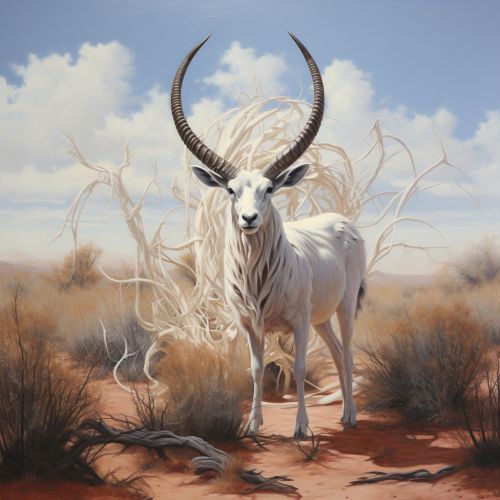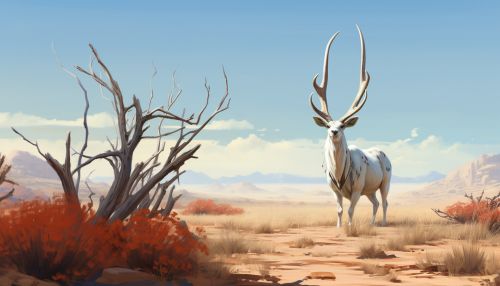Screwhorn Antelope
Taxonomy and Evolution
The Screwhorn Antelope, scientifically known as Addax nasomaculatus, belongs to the family Bovidae and the genus Addax. This genus is monotypic, meaning the Screwhorn Antelope is the only species within it. The species was first described by Henri de Blainville in 1816. The specific name, nasomaculatus, is derived from Latin words 'nasus' meaning nose and 'macula' meaning spot, referring to the distinctive facial markings of this species.


Description
The Screwhorn Antelope is a medium-sized antelope, with males standing about 105 to 115 cm at the shoulder and females slightly smaller. The most distinctive feature of this species is its long, twisted horns, which have given it its common name. Both sexes possess these horns, with those of males being longer and more robust. The body coloration varies with the seasons - in winter, the coat is greyish-brown with white hindquarters and legs, while in summer it turns almost completely white, presumably to reflect the intense desert sun.
Distribution and Habitat
The Screwhorn Antelope is native to the Sahara Desert, once widespread across North Africa. However, due to extensive hunting and habitat loss, its range has been drastically reduced and it is now considered one of the most endangered large mammals in the world. The species prefers sandy and stony desert habitats, where it can utilize its specialized hooves to traverse the loose, shifting sands.
Behavior and Ecology
Screwhorn Antelopes are primarily nocturnal, seeking shelter from the harsh desert sun during the day and becoming active in the cooler night hours. They are highly adapted to their arid environment, able to extract sufficient moisture from their food to survive without drinking water for long periods. Their diet consists mainly of grasses and leaves, but they will also consume shrubs and herbs when available.
Reproduction
The mating season of the Screwhorn Antelope occurs once a year, usually in the early spring. After a gestation period of about nine months, a single calf is born. The young are precocial, able to stand and follow their mothers within a few hours of birth. They are weaned at around six months of age and reach sexual maturity at around two years.
Conservation Status
The Screwhorn Antelope is listed as Critically Endangered on the IUCN Red List. The primary threats to this species are unregulated hunting and habitat loss due to desertification and human encroachment. Conservation efforts are underway to protect and restore the population, including captive breeding programs and the establishment of protected areas within its native range.
Cultural Significance
In some cultures, the Screwhorn Antelope is considered a symbol of purity and endurance, reflecting its ability to survive in harsh desert conditions. Its horns are also highly prized by trophy hunters, contributing to its decline in the wild.
